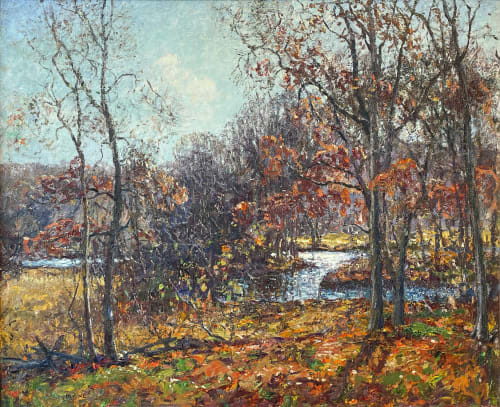A prolific Impressionist with a penchant for atmospheric scenes, Illinois native Wilson Irvine began his career in Chicago as an airbrush artist. His expertise led to his eventual employment with the newly founded Chicago Portrait Company, where he retouched photographs to achieve highly realistic results. It was not until 1895 that Irvine enrolled in evening classes at the Art Institute of Chicago, studying first with the academically trained Charles E. Boutwood and later with the illustrator Walter M. Clute. Beginning in 1900, Irvine’s landscape paintings appeared in forty-one exhibitions hosted by the Art Institute, and soon his work was seen at the Pennsylvania Academy of the Fine Arts, the Corcoran Gallery, and the National Academy of Design. Irvine was awarded a silver medal at the 1915 Panama-Pacific International Exposition in San Francisco.
Also in 1895, Irvine and a group of fellow artists founded the Palette and Chisel Club of Chicago. Members met on Sunday mornings at the studio of noted sculptor Lorado Taft to draw from the model during daylight hours. Irvine served first as the treasurer and then as president of the club, regularly participating in the group’s exhibitions, which were held at the art galleries of Marshall Field’s eponymous department store. In 1907, Irvine was one of the founders of the Cliff Dwellers Club, spearheaded by noted author Hamlin Garland. He was also active in the Artists’ Guild, which merged into the Arts Club, and the Chicago Watercolor Club.
Irvine traveled to France in 1908, where he painted scenes in Brittany at Pont-Aven and St. Malo—works that are decidedly impressionistic and demonstrate a keen interest in the effects of light and a tendency toward color contrasts. In 1914, Irvine began to spend time in Connecticut, the home of several Impressionist art colonies. After three summers in Hamburg, Irvine purchased a hillside property there in 1918 and made it his primary residence until his death. Hamburg is the town center of Lyme, located inland about five miles from Old Lyme, where a distinguished group of painters had been gathering since the late 1890s. By the time Irvine arrived in the area, Impressionism and plein air painting were well established.
That Irvine had achieved considerable success at this point in his career is documented by a hefty exhibition schedule. He was elected an associate member of the National Academy of Design in 1926, where he exhibited watercolors every year from 1921 to 1936. Irvine traveled increasingly in his middle age. In 1923, he spent ten months abroad, painting in Cornwall, Wales, and on the Outer Hebrides; he also visited London, Glasgow, Paris, Giverny, Avignon, and traveled through Italy. In North America, he ventured to Quebec, New Orleans, Virginia, and Vermont, and then returned to Europe in 1929, going to Paris, Marseille, and various places in Spain. He was in Charleston, South Carolina, three years later.
The extent of Irvine’s travels suggests a certain restlessness, which is also underscored by the artist’s experimentation with several techniques and media, including monoprints and aquaprints. He also started viewing his subjects through a prism, which resulted in a halo effect around the edges of objects revealing green tones against a light background, and red ones against a dark one; the optical results have been equated to color printing when slightly off-register. These unique technical investigations may have been Irvine’s response to the rise of modernism. Nevertheless, he remained an avowed and prolific Impressionist until his death in 1936. Examples of Irvine’s work can be found at the Art Institute of Chicago and the Florence Griswold Museum, among other institutions.
Works
Biography
Events
Enquire




